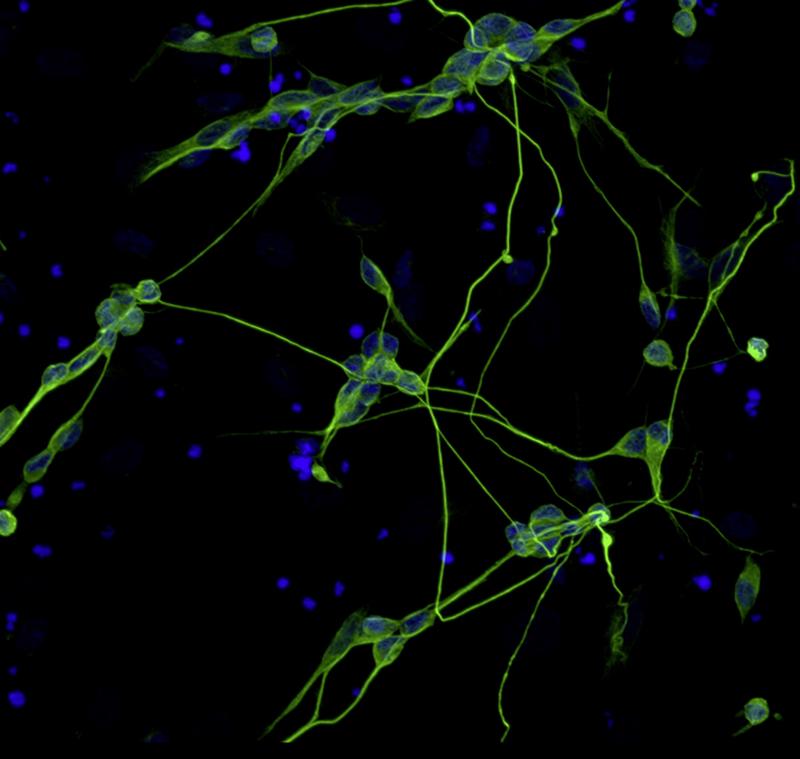Converting skin cells to neurons more efficiently
April 12, 2012

Nerve cells made from skin cells: the cells were dyed green by an antibody, with cell nucleus dyed blue (credit: Julia Ladewig/University of Bonn)
Researchers at the University of Bonn Institute of Reconstructive Neurobiology have converted skin and umbilical cord cells directly into nerve cells for disease research, cell replacement, and development of active substances.
Background
There was much excitement surrounding cell reprogramming with the breakthrough of Shinya Yamanaka. In 2006, the Japanese scientist was able to reprogram skin cells for the first time with the aid of a few control factors into so-called induced pluripotent stem cells (iPS cells) — “multipurpose” cells from which all body cells can in principle be produced.
In 2010, Marius Wernig at Stanford University developed the idea further: Using only three so-called transcription factors, his team was able to perform direct transformation of skin cells into induced neurons (iN). However, the method has so far been rather inefficient: only a small percentage of the skin cells were converted into the desired nerve cells.
Increasing efficiency using small molecules
University of Bonn scientists are taking it a step further. Julia Ladewig, post-doctoral researcher and lead author of the study, began using “small molecules” to influence several signaling pathways important for cell development.
By blocking the SMAD signaling pathway and inhibiting glycogen synthase kinase 3 beta (GSK3ß), they increased the transformational efficiency by several times and also simplified the means of extraction.
Using only two (instead of three) transcription factors and three active substances, the Bonn researchers were able to convert a majority of the skin cells into neurons. Their cell cultures contained up to more than 80% human neurons. And since the cells divide even further during the conversion process, the actual efficiency is even higher.
Two nerve cells produced from one skin cell
“We can obtain up to more than 200,000 nerve cells converted in this way from 100,000 skin cells,” says Ladewig. To find the right combination of active substances, the Bonn scientists are focusing on signaling pathways that are especially important for cell specialization.
“The SMAD signaling pathway and also GSK3ß were suspected of inhibiting the conversion of connective tissue cells and pluripotent stem cells into neural cells. The obvious step was to block both of them using corresponding active substances,” says Philipp Koch, team leader and senior author responsible for the study, together with Prof. Oliver Brüstle, director of the Institute of Reconstructive Neurobiology.
“We were able to demonstrate how the genes typical for skin fibroblast were gradually down-regulated and nerve-cell-specific genes were activated during the cell transformation. In addition, the nerve cells thus obtained were functionally active, which also makes them interesting as a source for cell replacement,” says Ladewig.
The Bonn scientists have already transferred the method to other types of cells such as umbilical cord cells. “First of all, we want to use nerve cells obtained in this way for disease and active substance research,” says Brüstle. “The long-term goal will be to convert cells directly in the body into nerve cells.”
Ref.: Ladewig, J. et al., Small molecules enable highly efficient neuronal conversion of human fibroblasts, Nature Methods, 2012 [DOI: 10.1038/nmeth.1972]